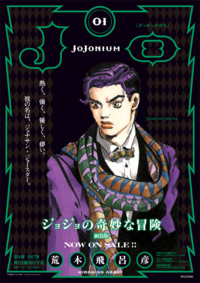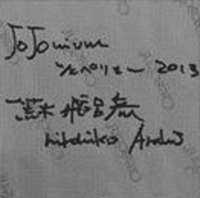JoJonium Vol. 1-3 (December 2013)
MYM Buzz (October 2013)
Interview Archive
A series of interviews by Hirohiko Araki included in the JoJonium release of Phantom Blood, which were published in three volumes between December 4, 2013, and January 4, 2014.[1][2]
Interview
Volume 1 (Jonathan Joestar)
There are limitations on how I could write the character because he was a "symbol of justice," so he may be a little on the boring side. I solidified his character as I went. Jonathan is passive, reacting to Dio's various attacks, and this leads to him discovering his way of life. Perhaps this is linked to me as an author, growing along with my character as I drew him. Just as Jonathan was unsure as to how to live his life, I was unsure where to take the character. Maybe I grew as an author a little with Jonathan as he trudged on through his hardships.
In Part 1, during the seven years after Danny's death, Jonathan gets very muscular. This change was made with the upcoming battle between him and Dio in mind. I thought his physique needed to be able to withstand the constant onslaught from this point on. In addition, when this part was originally being serialized, it was the era of "muscles" on the silver screen—guys like Schwarzenegger and Stallone. Schwarzenegger, for example, could never be stopped by an amount of gunfire right? I wanted Jonathan to have a similar look to him—a look of unstoppableness. Weekly Shonen Jump also has a history and tradition of main characters evolving and growing.
I also wanted Jonathan to exude an aura of strength like in Karate Baka Ichidai after doing martial arts training alone in the mountains. As a child, I loved karate manga—you would see all kinds of supernatural strength, like punching electrical poles and having the birds on the wires drop down or someone trying to stab another person with a knife, only to have the knife bend. In actuality, martial arts does have a certain mystique to it, such as strengthening punches with breathing techniques. I wanted to include supernatural things like that in JoJo, and I believe that the Ripple is inspired by my love of karate manga.
Q. Did Dio and Danny make up?
A. Just for the cover. It's hard drawing characters from Part 1 after all this time, but it feels like meeting up with old friends.Volume 2 (Will Anthonio Zeppeli)
Mr. Zeppeli[a] was named after the rock band "Led Zeppelin." They are top-tier musicians to me, so I felt I had to reference their name with this character, albeit it's really a shame I used it so early—kind of like playing the Joker right at the beginning of a card game. Therefore, I had to resolve myself to that when I debuted Mr. Zeppeli. It's also important how the name sounds; there are a lot of "J" names in the series like JoJo, Jonathan and Joestar that are similar, so I wanted to balance out the names with a "Z" like Zeppeli. I made sure to do the same thing with Speedwagon.
Mr. Zeppeli teaches the Ripple to Jonathan and leads him on his quest to destroy the stone mask. I like teachers who are silly and make you wonder whether or not they're missing a screw up there. Like in Jackie Chan movies, the master's always a drunkard—so how can he be so strong? Same thing in The Karate Kid. Their outside appearance may be a little off, but it's what's underneath that is deserving of respect. These characters have charm because of the gap between their exterior and interior, and because you can't judge them by their covers. Mr. Zeppeli may look weak at first glance, but he's actually strong, even though I dressed him like a magician and gave him the mustache of a snake oil salesman. His mustache was actually inspired by those worn by the painter Salvador Dali and Osomatsu-kun's Iyami.
However, the mustache requires a lot of courage to pull off in a shonen magazine. Mainly because it makes the character look older and untrustworthy, no matter the type of mustache. As for Mr. Zeppeli—while he serves as JoJo's master, it's not like he's an old man far older than JoJo. He's also the lead supporting character. I might have turned readers off with him, so it took courage. He's a type of character that I haven't really used in any of my other work, but one that I wanted to use for the reasons I mentioned above. Thinking about it now, it may have been a "gamble" or "adventure" on my part. Back then I probably figured, "Eh, it's JoJo, it'll work out." It is a Bizarre Adventure, after all.
Lastly, to my credit, JoJo's Bizarre Adventure (JoJo no Kimyou na Bouken) came out before the Japanese TV drama series Bizarre Stories in This World (Yonimo Kimyou na Monogatari). Let's get this straight.
Q. Could the sphere on his cane be…?
A. It's a steel ball from Steel Ball Run. Zeppeli is known for his silken top hat. It's a cool shape and if you curve the diamond design, it looks three-dimensional. ツェペ
波紋を教え、石仮面を破壊へ導くジョナサンの師ツェペリさん。僕が思うに先生というのは一見、ふざけている感じやコイツで大丈夫なの?というのがイイんですよ。ジャッキー・チェンの映画であれば、コイツ酒飲んでいる酔っぱらいなのになんで強いんだ?っていう感じ。『ベスト・キッド』の師匠もそう。こんなヤツが…というキャラクターに対して、その内面には尊敬すべきものがある。そういうギャップというか、表面だとか見た目じゃないところに魅力を感じる訳です。
弱そうに見えて、実は強いというイメージで、外見はマジシャンっぽい雰囲気になり、詐欺師のようなヒゲもつけました。このヒゲは画家のサルバドール・ダリや『おそ松くん』のイヤミとか、そういう系統です。
ただし、ヒゲというのは特に少年誌では非常に勇気のいるパーツなんですね。まず老けて見えるし、うさん臭い感じになる。これはどんなヒゲでも同じだと思います。ツェペリさんの場合、師匠とはいえジョナサンとすごい年が離れた老人でもない。しかも準主役。もしかしたら、読者からソッポを向かれるかもしれない。だから勇気がいるんですよね。彼は今までの作品であまり出したことのないキャラクターだったけれど、ここはさっきの“コイツで大丈夫なの?”って感じを出すために決断して。今思えば“賭け”というか“冒険”だったのかもしれないです。その時はまぁ『ジョジョ』だからいいだろうって気持ちもあったんでしょうね。タイトルも『奇妙な冒険』だったし。
最後に名誉のために言うと、TVドラマの『世にも奇妙な物語』よりも『ジョジョの奇妙な冒険』が世に出たのは先なので。そこも強調しておきましょう。
※荒木先生は原画裏面のサインにも、ツェペリだけ敬称を表記
Q. 杖に見える球体は、もしかして?
A.『スティール・ボール・ラン』の鉄球です。
ツェペリさんといえばシルクハット。その模様の菱形は曲線にすると、立体に見えていくイイ形なんですよ。
Volume 3 (Dio Brando)
In regards to how he contrasts with Jonathan, I wanted to tackle how you represent the ultimate villain as depicted against a symbol of justice. How exactly would he fall into that role of "villain"? People always love to compare who's stronger or who's cooler. You've got Godzilla versus Mechagodzilla, Schwarzenegger vs. Stallone… I wanted there to be that sort of contrast or struggle between Dio and Jonathan.
Additionally, FBI psychological profiling was a hot topic around the time that I wrote this. Why do serial killers do what they do, scientifically speaking? I was inspired by that when I was working on Dio. Guys like that are true scumbags, rotten to the core. Yet, I've always sort of thought that they're actually incredibly strong for being able to commit such crimes. Why do they go so far? Do they do it just to see if they can? The "control" aspect of it interests me as well. There was a famous case in America where a man trapped several women in a room and brought them out, one at a time, into another room to kill them. All of these women were waiting, together, for their turn to get killed. I can't imagine what their mental state was like at that point… Thinking rationally, you wonder why they wouldn't try to make a break for it, or why they wouldn't try to band together and overpower the killer? There has to be some way to resist. However, if you look into the process by which people control others, you start to see what's effective. There are many ways, including instilling fear, but I always found the act of controlling others strangely fascinating.
That's why Dio wasn't simply a strong villain, but a character that controls others and had admirers that served him. As an antagonist, it makes it suspenseful for the reader, as they wonder how he can be beaten. During serialization, I actually hadn't prepared a weakness for Dio. It's the best kind of suspense when you are on edge. How will they overcome him if Ripple doesn't work? The stronger the enemy, the better. It was hard coming up with a way for him to be defeated, though.
Q. Why is Dio naked?
A. He wanted to show off his beautiful body. If I try, I can draw these characters to look the way they did, but they're living, breathing things. They do end up looking like completely different people when drawn in a modern style. ジョナサンの時もお話したように、第1部で僕が描きたかったのはディオでした。人間が究極まで行こうとしたらどこまで行けるのか?限界はどこにあるのか?そういう野心を持ったキャラクターを描きたかったんですよね。音の響きをジョジョと比べてみて、イタリア語で“神”を意味する、ディオという名前になりました。よく“そこから取った説”でバイクのDIOから…というのも聞きますが、僕がディオと名付けた方が先なので!前巻の『奇妙な冒険』に続いて名誉のために言っておきましょう。
ジョナサンとの対比で言えば、正義の象徴に対する究極の悪役とはどんなヤツなのか。そして何をすれば悪役になるのかっていうね。よく“どっちが強い”とか“どっちが凄い”という比較があるじゃないですか。ゴジラ対メカゴジラやシュワルツェネッガー対スタローンみたいな。ディオとジョナサンの対比には、そういう対決とか競演という発想がありました。
また、時代背景で言うと、FBIの心理捜査みたいなことが流行り出したのはこの頃でした。“科学的に無差別殺人犯を分析する”その影響がディオにもありますね。間違いなく悪党には違いない。違いないけれど、僕はこの犯罪者たちを“凄く強いヤツ”だなと思ったんです。何でここまでするのか?できるのか?というところに…。そして犯罪者たち特有の“人を支配する”ことに興味を持ちました。アメリカで起きた有名な事件には、犯人が何人もの女性をひとつの部屋に監禁し、隣の部屋で一晩の間、順番に一人ずつ殺していくというものがありました。被害者は皆、ひとつの部屋で殺される順番を待っている。その心理状態が凄い不思議というか…普通に考えれば、何でそこで逃げないの?とかみんなで襲ったら犯人に勝てるんじゃないか?とか、対抗手段があると思うんですよ。でもここに至るまでの“人を支配する”プロセスを調べると、どんなことが有効なのかが隠れている。単純な恐怖とか色々あると思うんですけど、その人を支配するという行為に不思議な魅力を感じたんですね。
だからディオは、ただ単に強いだけではなく、人を支配するとか人が憧れその多くが下僕になるというキャラクターになりました。そんなディオが敵でいるからこそ、サスペンスとしてはこんなヤツにどうやって勝てるんだ?となる訳です。連載中もディオの弱点は用意していませんでした。すぐに波紋が破られてしまうのも、敵の強さを乗り越えることがサスペンスの醍醐味なので。敵は強ければ強い方が良い。でもどうやって倒したらいいか考えるのは大変でしたけどね。
Q.ディオは何故ハダカ…?
A.肉体美を見せたかったからです。
そっくりに描こうと思えばできるけど、やっぱりキャラクターは生きているものだから。今風に描くと別人っぽく?なっちゃうんだよね。
Notes
- ↑ Even when he signs artwork, Zeppeli is the only character that Araki Sensei refers to as "Mr." (San in Japanese)




